How to Create Customizable Compensation Plans That Drive Results
Craft a winning compensation strategy template with clear goals, stakeholder involvement, and flexible pay structures. Act now to boost performance.
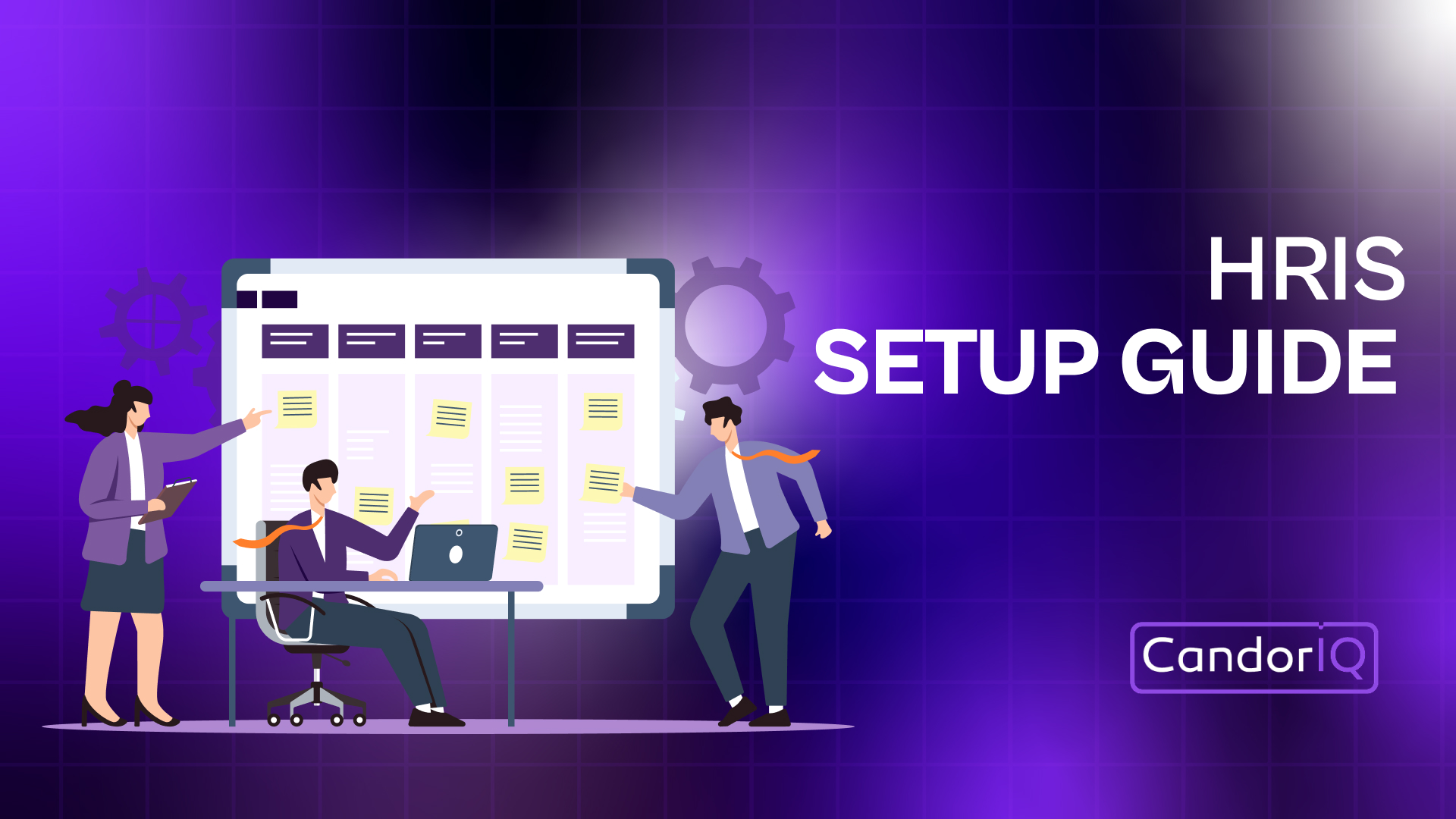
Compensation planning is no longer a one-size-fits-all exercise. As workforces become more diverse in roles, locations, and expectations, standardized pay structures often fall short. They can fail to reflect performance differences, regional cost-of-living variations, or evolving employee priorities like flexibility and long-term incentives.
According to ADP’s People at Work 2024 report, over 55 percent of workers rank pay among their top three job priorities, highlighting that compensation remains central to employee decision-making and satisfaction.
Customizable compensation plans offer a smarter approach. These frameworks accommodate varying needs across departments, geographies, and career stages while staying aligned with overarching business and financial objectives. Customization does not mean complexity; it provides HR and Finance with the control to build targeted, performance-aligned strategies that evolve with the workforce.
This blog breaks down how to create compensation plans that are not only equitable and scalable but also drive outcomes. From core components to implementation best practices, we will walk through the essentials of building a compensation model that delivers results.
TL;DR (Key Takeaways)
- Standardized pay structures no longer work. Diverse roles, locations, and expectations require modular, flexible compensation frameworks.
- Customization boosts retention and performance. When compensation reflects individual impact, market dynamics, and personal needs, employees are more engaged and loyal.
- Core compensation plans should include a mix of base salary bands, performance-based variable pay, long-term incentives (like equity), and non-monetary perks.
- Scenario planning and segmentation are essential. Align pay models with business goals by segmenting employees and stress-testing plans under different growth and budget scenarios.
- Mistakes to avoid include overcomplicating pay systems, neglecting equity compliance, and failing to align HR and Finance early in the process.
Why Customization Matters in Compensation Planning
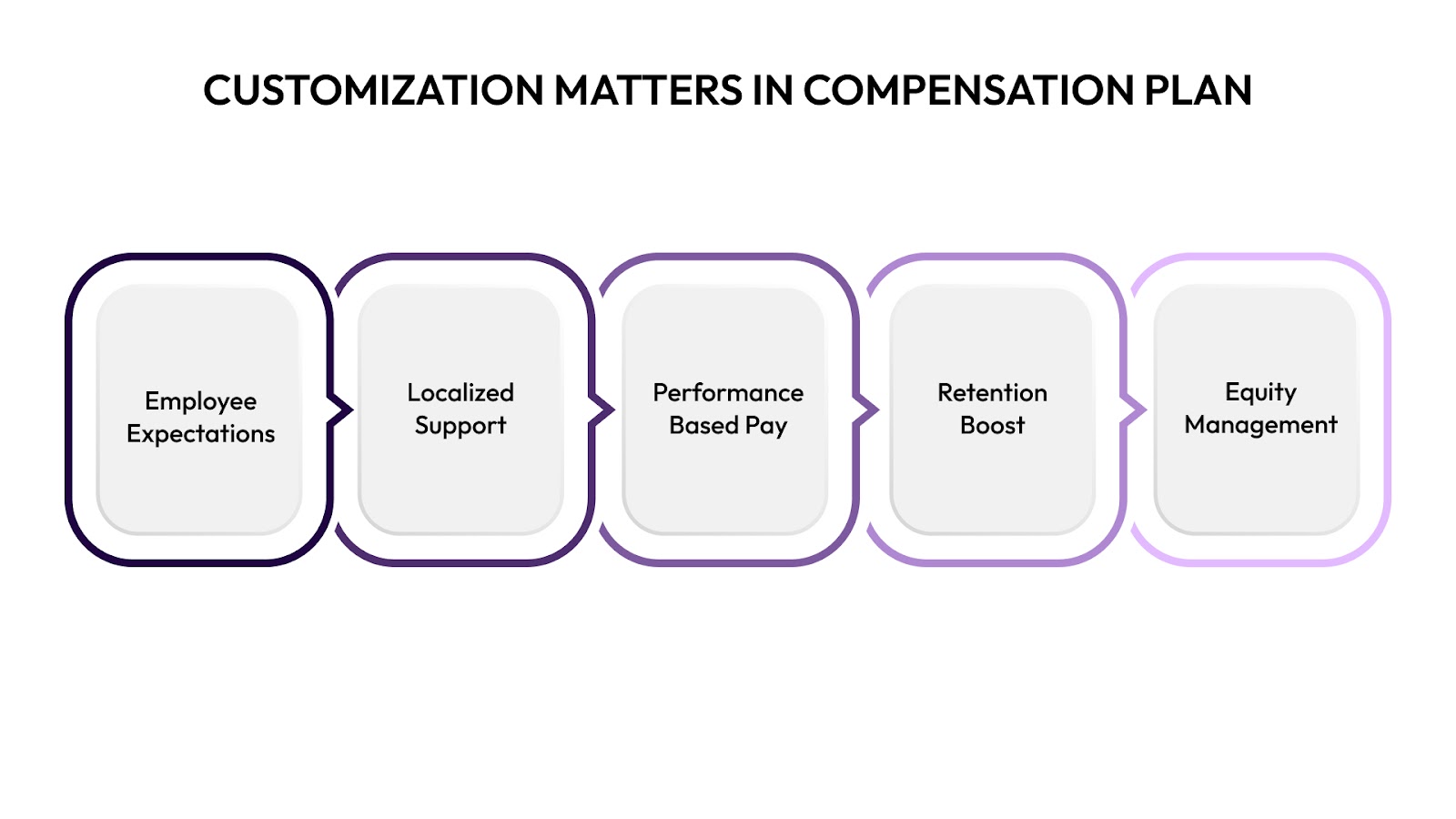
Standardized compensation models often fail to reflect the diversity of roles, markets, and performance levels within an organization. Customizable compensation plans help bridge this gap, offering a more strategic and people-centric approach.
Here’s why flexibility in compensation matters:
- Meets diverse employee expectations: Today’s workforce values fairness, personalization, and transparency. A customized plan addresses these demands more effectively than rigid structures.
- Supports regional and role-specific differences: Cost of living, talent availability, and role complexity vary widely across locations and functions. Tailoring compensation ensures your offer remains competitive and relevant.
- Aligns pay with performance and business impact: Flexible frameworks allow for differentiated rewards based on contribution level, helping organizations incentivize high performers and critical roles appropriately.
- Improves retention and engagement: When employees feel their efforts are fairly recognized and rewarded, they’re more likely to stay and stay motivated.
- Enables proactive equity management: Customization lets organizations spot and correct pay gaps early, improving internal equity and reducing risk of compliance issues.
In short, customization transforms compensation from a standard payout system into a strategic tool for talent management.
Core Components of a Customizable Compensation Plan
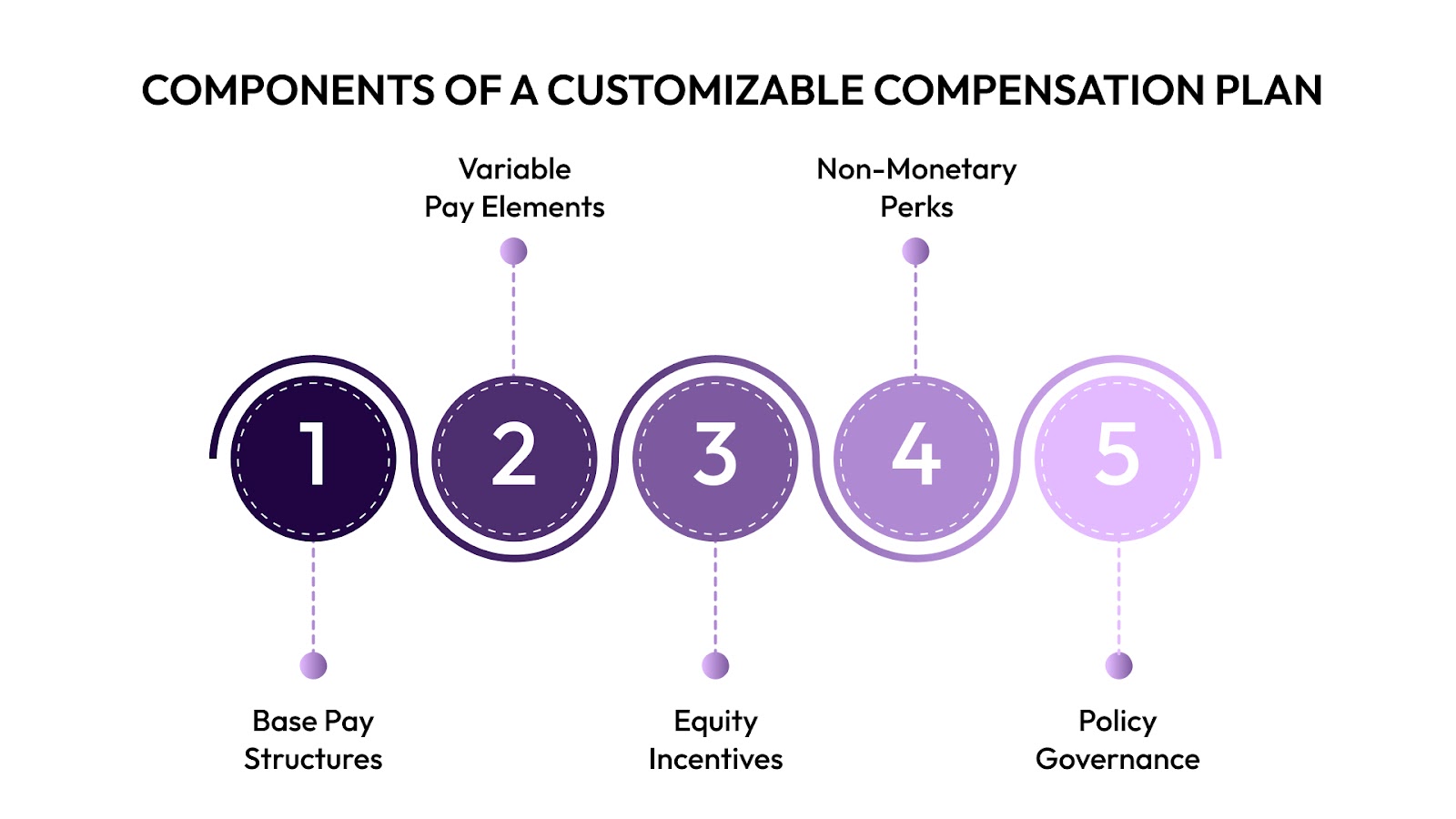
A well-structured customizable compensation plan is built on a set of modular elements. These elements allow HR and Finance teams to tailor rewards to different employee groups while maintaining overall consistency and control.
Key components include:
- Base Pay Structures: Instead of using flat rates, organizations often set salary bands or pay tiers based on role complexity, location, and market benchmarks. This structure supports internal equity while allowing flexibility where needed.
- Variable Pay Elements: Performance-driven bonuses, commissions, and profit-sharing schemes introduce an adaptable layer tied to individual, team, or company outcomes. These are ideal for motivating specific behaviors or rewarding short-term achievements.
- Equity and Long-Term Incentives: Stock options and RSUs provide alignment between employee interests and business growth. These are particularly effective for senior roles or high-impact positions where long-term retention is a priority.
- Non-Monetary Perks: Beyond salary, customizable plans often include flexible benefits, remote work options, learning stipends, or tailored recognition programs. These perks enhance total compensation value and support individual preferences.
- Policy Rules and Governance: Clear eligibility criteria, payout timelines, and budgeting frameworks help manage consistency and compliance across varied plan designs. This ensures that customization doesn’t compromise transparency or control.
Each component offers a lever for personalization. When combined thoughtfully, they create a compensation experience that supports performance, equity, and retention across a diverse workforce.
Steps to Build a Compensation Plan That Can Flex
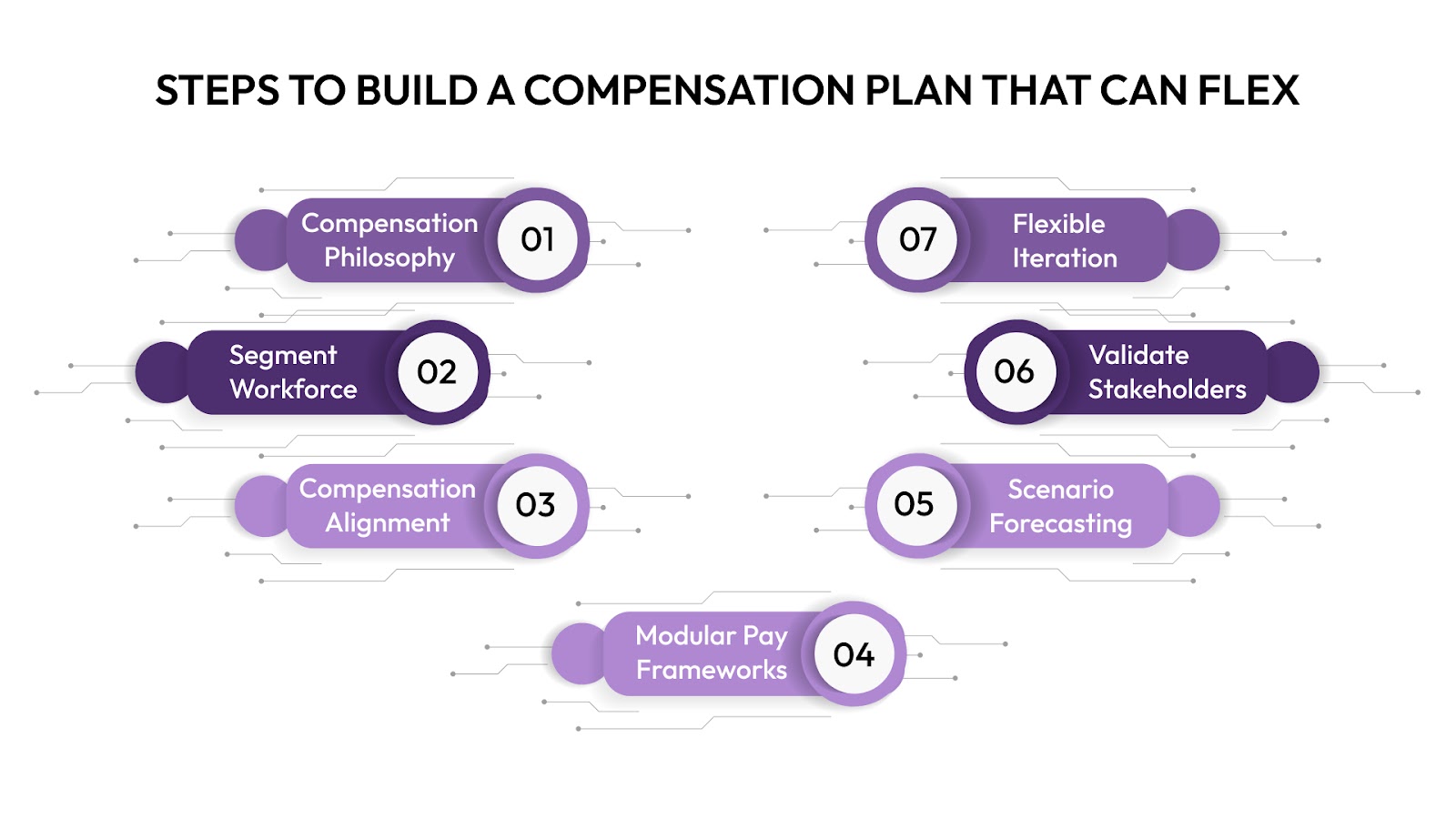
Creating a compensation plan that adapts to business needs and employee expectations requires a deliberate, structured approach. Below are the essential steps to building a plan that’s both strategic and scalable:
1. Define Compensation Philosophy
Start with a clear articulation of what your organization values in its reward strategy. Are you prioritizing market competitiveness, internal equity, performance differentiation, or retention? This philosophy will serve as the lens through which all plan elements are evaluated.
2. Segment Your Workforce
Group employees by meaningful categories such as role type, seniority, geography, or business unit. This allows compensation elements to be tailored to the unique demands, risks, and contributions of each group without overcomplicating the system.
3. Align with Business Objectives and Budgets
Ensure compensation strategies support near- and long-term business goals. Tie budgets to realistic forecasts and balance financial sustainability with competitive positioning.
4. Create Modular Pay Frameworks
Design pay structures using interchangeable components such as fixed vs. variable pay ratios or eligibility for different bonus programs. Modular design makes it easier to adjust compensation without rebuilding the entire system.
5. Incorporate Scenario Planning and Forecasting
Use data to model various “what-if” scenarios. How would a hiring surge affect pay equity? What happens if bonus targets are missed company-wide? Forecasting helps you build resilience, not just current needs.
6. Validate with Stakeholders
Before rollout, engage HR, Finance, and business leaders to review plan details. Their input ensures the plan is practical, sustainable, and aligned with operational realities.
7. Build in Flexibility for Ongoing Iteration
Treat your plan as a living framework. Use periodic reviews, feedback loops, and data triggers (e.g., turnover spikes, performance shifts) to make timely updates while keeping governance tight.
When these steps are followed, compensation planning becomes not just a process but a capability that evolves alongside your workforce and business strategy.
Common Mistakes to Avoid
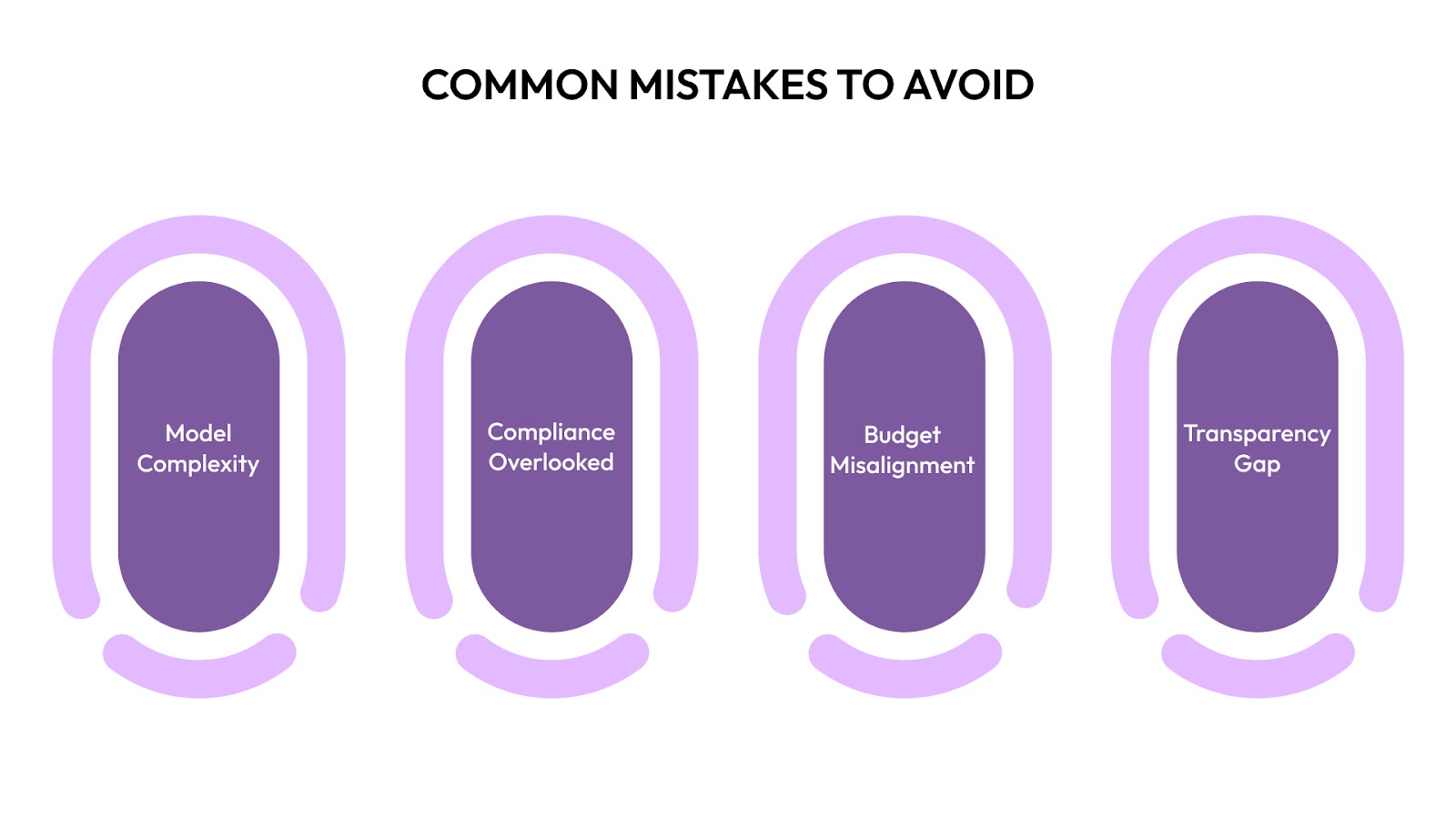
Even well-intended compensation strategies can fall short if certain pitfalls aren't addressed early. Here are common missteps that can undermine the effectiveness of customizable compensation plans:
- Overcomplicating the model with too many variations: Trying to tailor every detail for every role or region can create administrative chaos. When flexibility turns into fragmentation, consistency and clarity are lost, making it harder to manage and scale.
- Ignoring compliance and pay equity requirements: Failing to align with local labor laws or overlooking disparities in pay can expose the company to risk and damage trust. Equitable compensation is not just a value, it is a compliance requirement.
- Misalignment between HR and Finance on budgets and forecasting: When Finance teams are not looped in early, compensation plans may exceed allocated budgets or fail to align with financial projections. Lack of coordination leads to rework and delayed rollouts.
- Lack of transparency with employees: If employees don’t understand how their compensation is determined or how to influence it, motivation suffers. A well-designed plan must also be well-communicated to be effective.
Avoiding these mistakes ensures your compensation strategy remains fair, scalable, and aligned with both people and financial goals.
How Tools Like CandorIQ Enable Custom Compensation Design
Designing customizable compensation plans requires more than spreadsheets and fragmented systems. Tools like CandorIQ streamline the process by bringing compensation, performance, and budgeting data into a unified, interactive environment. Here's how it helps:
- Centralized Data Visibility: CandorIQ consolidates performance metrics, compensation history, and headcount forecasts into one platform. This allows HR and Finance to work with a consistent, up-to-date view of the organization, eliminating silos and errors.
- Real-Time Modeling and Comparison: With built-in scenario planning tools, users can build, test, and compare different compensation models instantly. Whether adjusting variable pay components or simulating geographic pay differentials, the platform enables quick, data-backed decisions.
- Compliance-Ready and Role-Based Access: CandorIQ includes configurable rules to meet internal pay equity standards and regional compliance. Role-based access ensures sensitive data is only visible to the right stakeholders, supporting both privacy and accountability.
- Seamless Cross-Functional Collaboration: By creating a shared space for HR and Finance, CandorIQ enables collaborative planning. Teams can align on budget thresholds, performance criteria, and plan iterations without waiting on manual data pulls or back-and-forth communication.
Together, these capabilities make CandorIQ an essential platform for organizations looking to design, manage, and evolve compensation structures that scale with business needs.
Who Benefits Most from Customizable Compensation Platforms Like CandorIQ?
While any organization can benefit from modernizing its compensation planning, certain leadership roles gain the most value from platforms like CandorIQ. These are the individuals responsible for aligning people strategy with business outcomes.
Chief People Officers (CPOs)
CPOs lead the charge in modern HR transformation. They oversee compensation philosophy, pay equity, retention strategies, and the broader employee value proposition. With CandorIQ, CPOs can:
- Translate business objectives into structured compensation strategies
- Monitor and correct pay equity gaps in real time
- Collaborate closely with Finance and Leadership teams
- Communicate compensation plans clearly to managers and employees
Chief Financial Officers (CFOs) and FP&A Leaders
Finance executives need visibility into how compensation plans impact budgets, forecasts, and financial risk. CandorIQ supports them by:
- Connecting compensation planning with financial modeling
- Providing budget adherence and forecast tracking
- Enabling collaborative planning with HR in one system
People Analytics Teams
These teams can identify compensation trends, gaps, and ROI using integrated compensation and performance data.
Organizations with Lean HR Teams
For companies with small HR functions owning compensation, CandorIQ eliminates manual work and enables structured, scalable processes.
Mid-Sized and Growth-Stage Companies
Especially valuable for companies between 100 to 2,000 employees that are undergoing rapid headcount expansion and need flexible, budget-aware frameworks.
By supporting these roles, CandorIQ helps leadership teams make faster, more confident compensation decisions that grow with the business.
Industries That Benefit Most from CandorIQ
While compensation challenges are universal, certain industries face unique pressures around pay equity, performance alignment, and rapid headcount growth. CandorIQ is built to support these sectors with structured, scalable compensation frameworks:
1. Technology and SaaS: Fast-scaling tech companies often deal with global teams, stock-based compensation, and evolving org structures. CandorIQ helps them build equity-inclusive, modular pay plans that scale with growth.
2. Professional Services: Consulting, legal, and agency-based firms need performance-driven and billability-aligned compensation. CandorIQ supports variable pay modeling tied to client outcomes, utilization, and career progression.
3. Healthcare and Life Sciences: Compliance-heavy industries like healthcare require role-specific benchmarking, transparent governance, and retention-focused compensation. CandorIQ centralizes data and supports audit-ready workflows.
4. Financial Services: Banks, insurance, and fintech firms benefit from structured bonus planning and equity frameworks. With CandorIQ, Finance and HR can co-own compensation modeling with built-in controls.
5. Manufacturing and Operations: For companies managing diverse hourly, shift-based, and salaried workers, CandorIQ enables flexible modeling that accounts for regional labor costs, shift differentials, and output-linked bonuses.
6. Retail and Consumer Goods: Retail companies rely on high-volume hiring, seasonal adjustments, and frontline incentives. CandorIQ simplifies planning across distributed teams with centralized budget control.
Conclusion
Customizable compensation plans are no longer a luxury; they are a necessity for modern organizations looking to retain top talent, adapt to regional and functional differences, and link pay directly to performance. As employee expectations evolve and business environments shift, rigid, one-size-fits-all models fall short.
Customization does not mean complexity. When done right, it means control, transparency, and strategic alignment. By structuring compensation to reflect business priorities and employee contributions, companies can create pay models that truly drive results.
If you're a Chief People Officer or HR leader ready to rethink compensation for today’s workforce, CandorIQ helps you centralize performance, pay, and budgeting into one powerful platform. Book a demo to see how it works.
Frequently Asked Questions (FAQ)
1. What is a customizable compensation plan?
Ans: A customizable compensation plan is a flexible pay structure that allows organizations to tailor salary, bonuses, equity, and benefits based on employee roles, locations, performance levels, and business needs. Unlike rigid pay models, these plans adapt to evolving workforce and organizational dynamics while maintaining fairness and control.
2. Why should companies move away from one-size-fits-all compensation?
Ans: Because workforces today are more diverse, hybrid, and performance-driven. Standardized models often ignore role complexity, regional cost-of-living differences, or strategic priorities. Customization ensures compensation stays competitive, equitable, and aligned with business goals.
3. Is customizable compensation more complex to manage?
Ans: It can be, without the right tools. However, platforms like CandorIQ streamline this complexity by centralizing data, enforcing governance rules, and enabling scenario planning. This allows teams to maintain flexibility without losing control or visibility.
4. How does CandorIQ support compensation planning?
Ans: CandorIQ brings compensation, performance, and budgeting data into one unified platform. It enables HR and Finance teams to model pay structures, monitor pay equity, adjust for geography or performance, and collaborate in real time on compensation strategy.
5. What types of companies benefit most from customizable pay structures?
Ans: Mid-sized and growth-stage companies (100–2,000 employees), especially in tech, healthcare, professional services, and finance. These companies often need scalable compensation systems that reflect internal differences while maintaining budget discipline and compliance.


